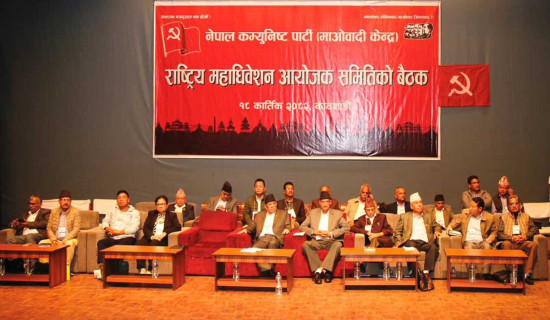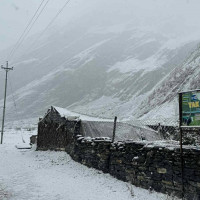- Tuesday, 4 November 2025
In Search Of Collaborative Diplomacy
Two important diplomatic events took place in South Asia early this week. India's Foreign Secretary Vikram Misri visited Kathmandu on Sunday at the invitation of Nepal's Foreign Secretary Amrit Bahadur Rai. Similarly, Chinese Foreign Minister Wang Yi visited New Delhi at the invitation of his counterpart Subramanyam Jayashankar on Monday. Ostensibly, Misri had come to Nepal to hand over the Indian Prime Minister's invitation to Nepal's Prime Minister KP Sharma Oli for an official visit to India, while Wang Yi had come to participate in the 24th round of talks on long long-standing border issue.
However, both the visits also had the intrinsic purpose of bringing about a thaw in their relations, passing through a chill phase. Nepal-India relations remain strained since the publication of a new political map by both countries, including Kalapani and Lipulake area in western Nepal on their territory and India's opening a trans-border road linking Uttarakhand and the Tibet Autonomous Region of China through the same disputed area. In the same way, India-China relations are also going through a difficult period since 2020 when a bloody military clash in the Ladhakh region resulted in the death of 20 Indian and 4 Chinese soldiers. Therefore, these visits can be said to have been directed more to building ties than merely serving as diplomatic exchanges.
Ice-breaker opening
In the past, India had the tradition of extending an invitation to Nepal's new head of government to visit India immediately after assuming office, followed by a return visit by the Indian Prime Minister. This time, however, India waited for a whole year to extend an invitation to the Nepali prime minister after the change in the government in Nepal. These diplomatic initiatives, therefore, can be considered as an ice breaker opening the way for further improvement in the neighbourly relations. These visits, though seemingly small, carry great significance as they have taken place at a time when the global power equation is going through a massive shift.
These diplomatic overtures can also be interpreted as a response to the need for collaborative efforts to give shape to the emerging multipolar geopolitical reality. China and India now realise that developing countries of South Asia expect a respectful partnership, investment in their infrastructures and a strong framework for a balanced regional cooperation through revitalisation of regional organisations like SAARC, BIMSTEC or other sub-regional organisations. So far, India has not been able to win the trust of its small neighbours by meeting this aspiration of its neighbours under its Neighbourhood First policy.
Contrary to this, however, China has provided substantial long-term infrastructural support to South Asian countries, though the China-built projects are lying in limbo because of India's non-cooperation. The Hambantota Port in Sri Lanka, the Deep Sea Port in northern Bangladesh and Nepal's Gautam Buddha International Airport in Bhairahawa are some examples which now run the risk of being white elephants because of the non-cooperation of India in their operation, citing security reasons. India could help these countries to operate projects instead of cornering them into a debt trap by making them dysfunctional.
As India and China rise as manufacturing industrial hubs of Asia, smaller developing countries can be both their market and sources of raw materials and cheap labour. At a time when their Western market is shrinking because of exorbitant tariffs being imposed against their goods, the need for them to expand and diversify markets becomes all the stark. India and China are trying to expand and diversify their markets by building trade relations with African, Southeast Asian, Caucasian, and South American countries. Building good relations with close neighbours will give them added strength to lead an emerging multipolar world.
In the context of an increasingly hostile geo-political environment, the importance of cultivating relations with close neighbours offers immeasurable advantages to both China and India. All the countries of South Asia, big or small, are endowed with immense natural and human resources and are in a position to offer opportunities to develop mutually beneficial joint ventures which could be tapped for the benefit of 2.088 billion people of South Asia.
Space of cooperation
As geopolitical and economic power centres shift to Asia, China and India must build a broad alternative space of cooperation with their close neighbours to resist the pressure from Western powers. The growing geopolitical tension between the West and the East is creating a compulsive environment for the major Asian powers to mitigate their differences and seek wider space for collaboration with close neighbours. The meeting between China's Foreign Minister Wang Yi and Indian Prime Minister Modi indicate a deep realisation that they need more collaborative space instead of highlighting differences.
The visit of Indian Foreign Secretary Vikram Misri, coinciding with the visit of the Chinese top diplomat to New Delhi, must also be viewed in a connected sequence of the evolving world order. Russia, China and India are feeling an urgency to diversify their trade and strategic partnerships to cope with the predatory policy of Western powers. Nepal will be able to catch pace with the fast-moving world only if it can align itself with the Asia-led world order by minimising differences and widening space for collaborative diplomacy. The upcoming visits of Nepal's Prime Minister Oli to India and China can be taken as a litmus test for Nepal
(Dr. Bharadwaj is a former ambassador and former chairperson of Gorkhapatra Corporation.bharadwajnarad@gmail.com.)









-original-thumb.jpg)






